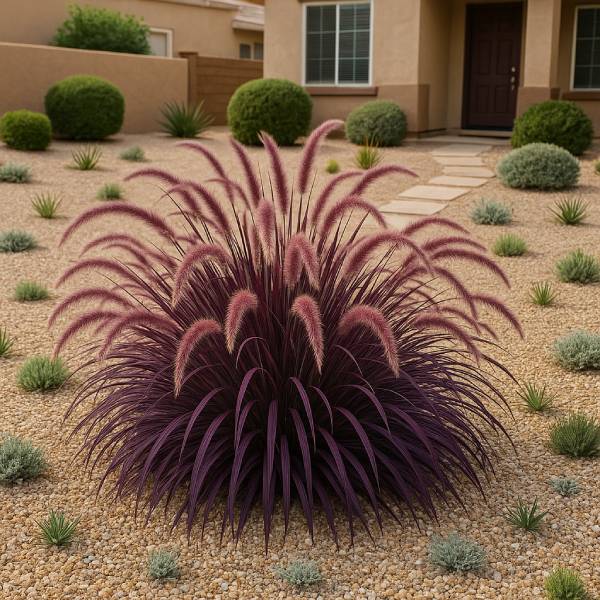Last updated on July 27th, 2025 at 03:31 pm
The care of Purple Fountain Grass (Pennisetum Setaceum ‘Rubrum’) will do well in and around the American Southwest. It does well in USDA zones 8 – 10 and needs to be cut down each year in cooler climates. It produces nice spiky arching plumes and purple/bronze colored thin leaf blades, thus its common name.

Lush, vibrant, and ornamental, Purple Fountain Grass adds a touch of exotic beauty to any landscape. With its striking purple/bronze-hued foliage and elegant arching plumes, this grass variety is a popular choice for gardens in the American Southwest, thriving in USDA zones 8 – 10. While its care may seem daunting to some, with the right knowledge and techniques, you can easily maintain and enjoy this stunning grass in your outdoor space.
Purple Fountain Grass can be a perennial or an annual, and it depends on your local weather. If you live somewhere mild, where winter temperatures almost never drop below 20°F, it acts as a perennial and comes back year after year. In regions with colder winters, where the temperature dips much lower, gardeners treat it as an annual. The cold can kill the plant, so it won’t survive to grow again in spring. Some folks try to overwinter it indoors in pots, but for most people in colder areas, replanting each year works best.
How big does Purple Fountain grass grow?
They will grow about five ft. tall and about the same width. In cooler regions, they need to be cut down to the ground and covered with mulch, especially in the higher elevations of the Southwest. They pop out in late spring or early summer. I have seen many landscapers and gardeners pull these plants out in mid-spring, thinking they have died.
Plant this ornamental grass in a good loamy garden or potting soil. Do not fertilize during the mid-summer months, only in spring and fall. It is best to use a good all-purpose fertilizer during early spring or fall.

Where to place these plants?
They love the full direct sun, but they can tolerate some shade. You can also place them in a decorative container and make sure the pot is large enough to accommodate the root system. Also, be sure to water it more often if it is in a pot. Remember, the pot/container retains heat no matter what it is made of.
Row or purple fountain grass
Plant 3-4 or more in a row for a great landscape scene.

This grass is considered a drought-tolerant plant and can be planted along with other desert-type plants. However, it is best to water daily after initial planting. Cut back during the fall season. It takes about three years for it to become a less water-intensive grass. Once established 2-3 times per week of watering is good throughout its lifetime.
Problems with Purple Fountain Grass
Slugs and snails love this plant. Treat with Sluggo ™ at the first sign of these pests. Slugs will normally eat away at the center of each grass blade. Fungus rust will also infect the purple fountain grass, the cause is too much water or overhead watering by the lawn sprinklers. Spray with Neem oil to remove fungus rust. It’s important to check on your plants regularly doing so and you will have a yard or landscape that will be the envy of friends, relatives, and neighbors.
Pests and Diseases: While Purple Fountain Grass is relatively pest and disease-resistant, it can occasionally fall victim to issues such as aphids, spider mites, or fungal diseases. Monitor the grass regularly for signs of pests or diseases, and treat them promptly to prevent further damage. Neem oil or insecticidal soap can be effective in controlling common pests.
More types of grasses for the southwest.

Greenhouse Manager, Master Gardener, and Webmaster.
If you have any questions or enjoyed this post, feel free to share your thoughts in the comments below.





